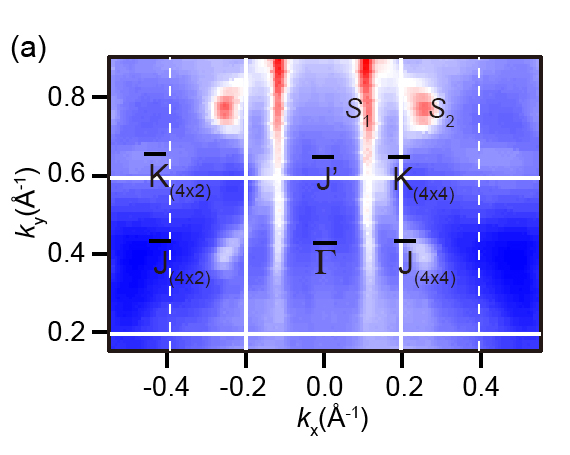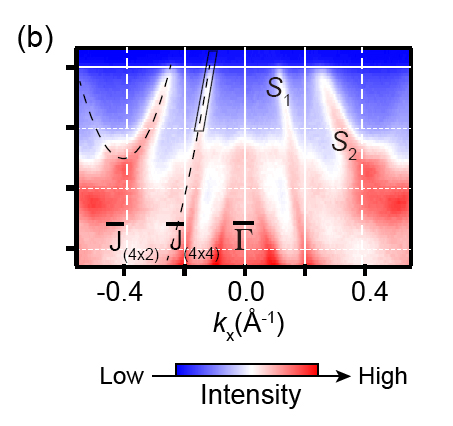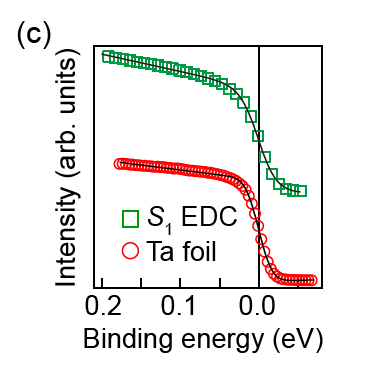Angle-resolved photoelectron spectroscopy (ARPES) experiments carried out at 6 K on on Pt/Ge(001) atomic nanowires provide new elements to better understand the physics of the one-dimensional electrons on solid surfaces.
Current interest of low-dimensional physics
In solid-state physics, we learn that electrons in one-dimensional metals undergo metal-to-insulator transition induced by the Peierls instability due to electron-phonon interaction or exhibit a Luttinger liquid behavior due to electron-electron interaction with decreasing temperature. Atomic nanowires formed on metal-adsorbed surfaces of semiconductor are offering an opportunity to investigate such intriguing phenomena of one-dimensional electrons. So far, however, the presence of defects in the nanowires largely hinders their manifestations. Highly-ordered atomic nanowires at surfaces are thus essential not only for clarifying if they exhibit the Peierls instability or a Luttinger liquid behavior, but also for understanding universal nature of one-dimensional electronic systems.
Koichiro Yaji’s group has succeeded to prepare single-domain samples of defect- and kink-free Pt-induced atomic nanowires on Ge(001) (Pt/Ge(001) NWs), which are very suitable for the study of one-dimensional electrons. The ground-state electronic properties of Pt/Ge(001) NWs at the Fermi level (EF) were investigated in situ on the CASSIOPEE beamline by angle-resolved photoelectron spectroscopy (ARPES) at 6 K, well below the temperature of the structural phase transition of Pt/Ge(001) NWs.
Experimental observation of an ideal one-dimensional metallic band
Angle-resolved photoelectron spectra of Pt/Ge(001) NWs were recorded on the CASSIOPEE beamline which allows to optimize the photon energy and to select a polarization with high energy and angle resolutions for investigating one-dimensional metallic surface bands. Figure (a) shows the Fermi-surface mapping at 6 K. From the Fermi-surface image, two metallic surface bands labeled S1 and S2 are clearly identified. The Fermi surface of S1 consists of straight lines in the ky direction, indicating that S1 disperses only in the nanowire direction. S1 is therefore an ideal one-dimensional metallic state which is electronically decoupled from neighboring wires. Figure (b) shows a typical band structure of Pt/Ge(001) NWs. S1 exhibits a steep dispersion and crosses EF in the substrate bulk band gap.
Fermi gas behavior of a one-dimensional metallic band
ARPES results clearly show that there is no gap opening at the Fermi energy EF. Therefore, S1 does not directly contribute to the structural phase transition and is stable against the Peierls instability if it exists. The electron-phonon interaction could not be strong enough to induce any structural transition with the nesting vector for S1 by the Peierls instability scheme. In order to examine a Luttinger liquid behavior, the energy distribution curve of S1 was analyzed as shown in Fig. (c). The spectral shape agrees with the normal Fermi-Dirac-type distribution function without any indication of the power-law behavior predicted for a Luttinger liquid.
New findings of one-dimensional electrons on solid surfaces
A metallic band of highly-ordered Pt/Ge(001) NWs exhibits strictly straight Fermi lines, clearly indicating that it is an ideal one-dimensional metallic state. On the other hand, the photoelectron intensity of the band is not suppressed at EF and the spectral shape is consistent with a Fermi-Dirac-type distribution function even at 6 K. These novel results being against both Peierls instability and Luttinger liquid schemes provide not only a valuable contribution to the phenomenology of nanowires/semiconductor systems but also a major advance for understanding the intriguing physics of the one-dimensional electrons on solid surfaces.

Constant energy ARPES map at EF of Pt/Ge(001) NWs with single-domain samples formed on the vicinal Ge(001) substrate. The photoelectron intensity is represented by color scale.

ARPES image taken along kx. Dashed curves represent the band structures of S1 and S2, which were fitted to the data.

The integrated energy distribution curve of S1 near EF in a surface Brillouin zone.
